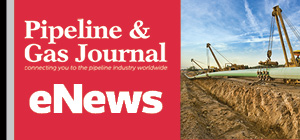Uncertainty Clouds EastMed Gas Pipeline Project Timeline, Stakeholders Say
(Reuters) — The timeline for a proposed pipeline connecting East Mediterranean gas reserves to Greece via Cyprus and Crete remains uncertain as stakeholders are reviewing its economic feasibility, delegates from Cyprus and the East Mediterranean Gas Forum (EMGF) told Reuters on Friday.
"There is no concrete timeline right now," George Papanastasiou, energy minister of Cyprus, told Reuters when asked about a Final Investment Decision (FID) on the so-called EastMed project.
Greece, Cyprus and Israel inked a deal in 2020 to build a 2,000-kilometer (1,240-mile) subsea pipeline to move natural gas from the eastern Mediterranean to Europe.
FID on the project, which is estimated to cost more than 6 billion euros ($6.42 billion), was originally expected last year but the Middle East conflict became a factor in delaying the decision.
Now, stakeholders in the project are assessing alternatives in light of the high costs associated with the pipeline and questions around its long-term viability as the world transitions away from fossil fuels.
Smaller alternatives to the EastMed project - like pipelines linking Cyprus to Egypt or Israel - should generate better returns before oil and gas are phased out, Papanastasiou said on the sidelines of the Economist Impact Eastern Mediterranean Business Summit in New York.
Papanastasiou last year detailed plans for a shorter pipeline to bring gas from Israel's East Mediterranean fields to Cyprus, where it could be partially liquefied for transportation to European markets.
Technical challenges in traversing difficult geographical terrains make the EastMed pipeline very capital intensive, while the relatively small amount of currently identified gas reserves in the region also raise economical challenges, EMGF Secretary General Osama Mobarez told Reuters.
"That's why some of the stakeholders are exploring different options for monetizing the gas resources. I think the development of the pipeline will depend on finding more gas in the region, significant volumes of gas that can justify the investments needed for this," Mobarez said.
For the short- and medium-term, existing LNG infrastructure in Egypt could be used as a viable option for East Med gas exports, according to Mobarez's team.
($1 = 0.9353 euros)
Related News
Related News

- Kinder Morgan Proposes 290-Mile Gas Pipeline Expansion Spanning Three States
- Enbridge Plans 86-Mile Pipeline Expansion, Bringing 850 Workers to Northern B.C.
- Intensity, Rainbow Energy to Build 344-Mile Gas Pipeline Across North Dakota
- Tallgrass to Build New Permian-to-Rockies Pipeline, Targets 2028 Startup with 2.4 Bcf Capacity
- U.S. Moves to Block Enterprise Products’ Exports to China Over Security Risk
- U.S. Pipeline Expansion to Add 99 Bcf/d, Mostly for LNG Export, Report Finds
- A Systematic Approach To Ensuring Pipeline Integrity
- 275-Mile Texas-to-Oklahoma Gas Pipeline Enters Open Season
- US Poised to Become Net Exporter of Crude Oil in 2023
- EIG’s MidOcean Energy Acquires 20% Stake in Peru LNG, Including 254-Mile Pipeline





Comments